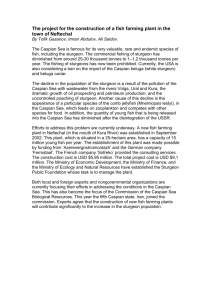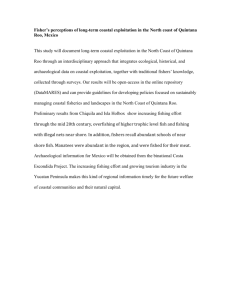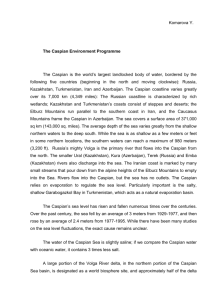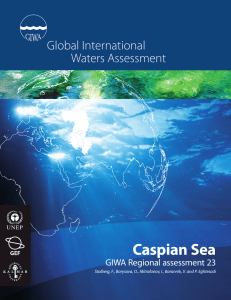A) Climate change, pollution and risks
advertisement
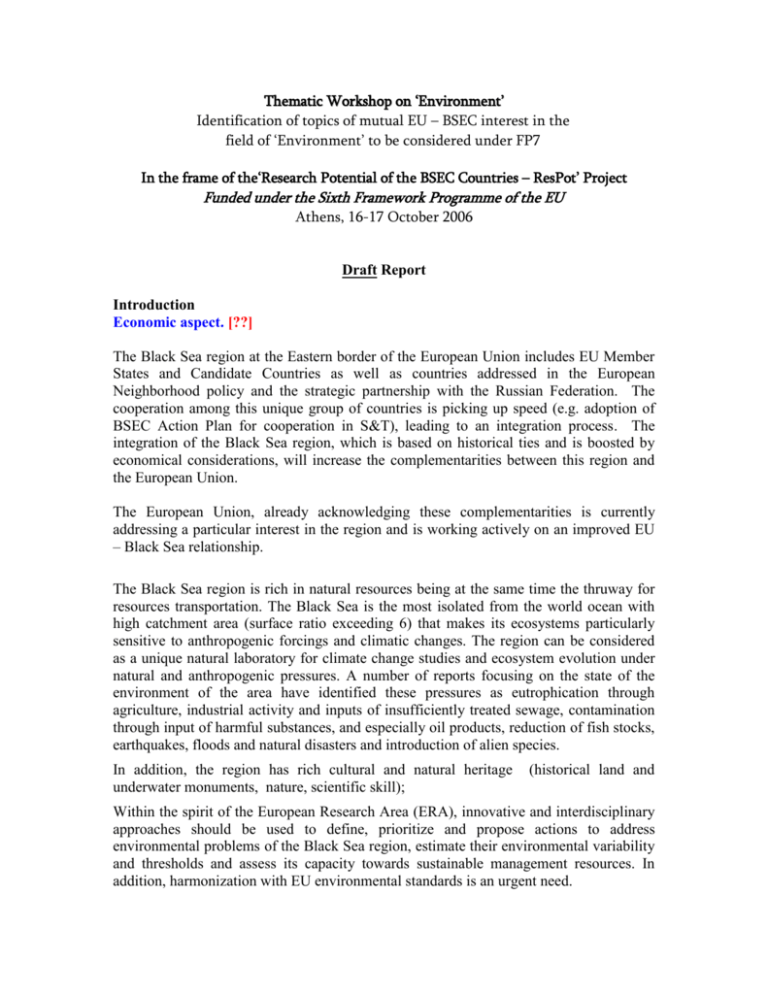
Thematic Workshop on ‘Environment’ Identification of topics of mutual EU – BSEC interest in the field of ‘Environment’ to be considered under FP7 In the frame of the‘Research Potential of the BSEC Countries – ResPot’ Project Funded under the Sixth Framework Programme of the EU Athens, 16-17 October 2006 Draft Report Introduction Economic aspect. [??] The Black Sea region at the Eastern border of the European Union includes EU Member States and Candidate Countries as well as countries addressed in the European Neighborhood policy and the strategic partnership with the Russian Federation. The cooperation among this unique group of countries is picking up speed (e.g. adoption of BSEC Action Plan for cooperation in S&T), leading to an integration process. The integration of the Black Sea region, which is based on historical ties and is boosted by economical considerations, will increase the complementarities between this region and the European Union. The European Union, already acknowledging these complementarities is currently addressing a particular interest in the region and is working actively on an improved EU – Black Sea relationship. The Black Sea region is rich in natural resources being at the same time the thruway for resources transportation. The Black Sea is the most isolated from the world ocean with high catchment area (surface ratio exceeding 6) that makes its ecosystems particularly sensitive to anthropogenic forcings and climatic changes. The region can be considered as a unique natural laboratory for climate change studies and ecosystem evolution under natural and anthropogenic pressures. A number of reports focusing on the state of the environment of the area have identified these pressures as eutrophication through agriculture, industrial activity and inputs of insufficiently treated sewage, contamination through input of harmful substances, and especially oil products, reduction of fish stocks, earthquakes, floods and natural disasters and introduction of alien species. In addition, the region has rich cultural and natural heritage underwater monuments, nature, scientific skill); (historical land and Within the spirit of the European Research Area (ERA), innovative and interdisciplinary approaches should be used to define, prioritize and propose actions to address environmental problems of the Black Sea region, estimate their environmental variability and thresholds and assess its capacity towards sustainable management resources. In addition, harmonization with EU environmental standards is an urgent need. The Black Sea region possess a strong scientific potential on Environmental issues that can contribute significantly to all the objectives of the Thematic Priority “Environment” in the 7th Framework Programme. In parallel, the Black Sea region presents a series of specificities that need particular attention since they present a specific mutual interest, in the context of the EU – Black Sea S&T cooperation in the field of Environment. These specificities include: A- Climate Regional climate of the Black sea / Caspian regions and its impact on basins stratification, regional air-sea interaction, ecosystem and landscape dynamics. A.1 Paleoclimate of the Black and Caspian seas. Brief description The isolated basins Caspian and Black Seas are unique laboratories for past climate change evaluation. At present the knowledge of the past climate variability is provided by the resukts obtained from ice core or coral reef analyses. Nevertheless, the recent mid latitude paleo-climate approach faces the fact that the Global Ocean reacts or has reacted with delay to the atmospheric climate change (hysteresis effect). The Black Sea and Caspian Sea, being in direct connection with the draining rivers of the melting of the ice (Danube, Dniper, Dniestr, Don, Volga, Kura etc.) and disconnected from the Global Ocean recorded perfectly this climate variability and are prefect archive for pas climate variability record. This archives are preserved in the Black Sea and Caspian Sea stratigraphy and could be used when interpreted to climate modeling which need to be feed by past climate records to understand the future. Justification: If you want to understand future climate variability, knowledge of the past is needed. For this the Black Sea and Caspian Sea provide one of the best World records of the last rapid climate changes. Expected impact: More new accurate paleo-climate results to feed running climate models will be provided. The Black Sea and Caspian receiving basins from big rivers make them good recorder of changes in the climate and water cycle. [need to be strengthened] Existed Expertise; Black Sea and Caspian Sea countries started preliminary paleo-environmental climate studies in these regions and need European collaboration for standardization of models. Reference to the most appropriate tool: Large scale project A. 2 Formation stability and overturning of the regional seas stratification. Brief description The Black Sea and the Caspian basins have specific story of the formation and evolution of thermohaline stratification. They are also good natural laboratories of turbulent mixing studies. There is evidence of the overturning of the Caspian Sea but the stability of the Black Sea stratification is not investigated yet. The BS has restricted exchange with the Global Ocean (a restricted pathway through Bosporus), so a strong permanent halocline develops and it was believed that it prevents deep ventilation in the interior of the Black Sea. However recent profiling float data released by the Black Sea riparian countries observed intense deep currents which indicates that deep ventilation could be underestimated. Justification Black and Caspian seas are basins without strong tides. Therefore they could be considered as examples of the mixing processes alternative to that induced by the breaking of tide generated internal waves and their specific input to the formation of the basins stratification. The study of the basins stratification stability is important for the forecasting of potential abrupt changes of the basin-scale water mass structure and their impact to the ecosystem. The stratification formation and evolution is directly connected with the deep-circulation formation and with ventilation processes. Expected impact: More efficient mixing parameterization will be proposed which makes possible to increase the quality of medium-range and long-term climatic forecasts of the basin evolution. Stability analysis should show the probability of significant changes of the basin dynamics and its impact to the basin ecosystem. The understanding of the Black Sea deep circulation is important for the correct climatic prediction of the basin dynamics and ecosystem. Existence of experience: The set of scientific groups cooperated under the umbrella of the Black Sea GOOS1 project and participated in FP5 and FP6 projects ARENA, ASCABOS are able to fulfill this work in cooperation with European scientists. Reference to the most appropriate tool: Medium size project A.3 Regional climate modulation by the air-sea-aerosol interaction. Brief description The Black/Caspian seas provide examples of the regional air-sea interaction with monsoon – like atmospheric effects. This regional modulation could be important for the climatic changes in the region. The Black Sea subjected also to the remote climatic control from the Eastern Mediterranean through the aerosol transport. Aerosols play a key role in weather modification and climate. The Eastern Mediterranean area is the cross-road of aerosols e.g. Sahara dust and Arabian dust in the case of the Black Sea 1 Global Ocean Observing System. countries. The aerosol transport provides possible links to the climate variability and weather modification between Eastern Mediterranean and the Black/Caspian Sea regions. Justification Regional weather modification and prediction as well as climate evolution may be strongly affected by a possible interaction with Eastern Mediterranean area, a question to be investigated. Therefore it is imperative that the driving mechanisms must be fully understood. Expected impact: The knowledge to be gained from such studies will be valuable to European Union and non-European Union member countries in the sense that the understanding of the mechanisms that drive weather may influence Southern Europe and Black/Caspian Sea region. Moreover, climate change characteristics in the Black Sea area may prove to have an impact on the European continent. This further has a direct impact on the sustainable economic development in Europe. Existence of the experience: Several research groups from the Black Sea countries are active in the field of climate and weather modeling. With the implementation of a co-operation with European Union research teams a mutual scientific benefit will be gained. Reference to the most appropriate tool: Medium-sized research projects. A.4 Assessment change climatological and agrometeorological conditions in Black Sea region as a results of global climate change Brief description The Black Sea region is characterized by the high level of agricultural production. Therefore the climate change will influence the quantity and quality of agriculture production and food provision. Evaluation of the impact of climate change on land use, agriculture, recreation conditions and landscape biodiversity dynamics is an important regional problem. Climate change also will contribute to the development of the desertification processes in the region. Justification Climate has a great influence on the productivity on the natural and man-made landscapes. At present important attention is attracted to the obtaining of the pure ecological production [??]. Thus, assessment of the landscape potential will contribute to increase the volume of ecological food production and optimization of the land use. Expected impact The solution of the problem will contribute to increase of the food security and improve human life conditions. [need to be strengthened] Existence of the experience: There is experience and initial results obtained by the Black Sea region specialists in the field of the assessment of the climate condition from models obtained by climate change simulation and also from agro-climatic and unfavorable meteorological phenomena. Reference to the most appropriate tool: Medium range project A.5 Determination of pollutant hot spots and sensitive areas in the Black Sea region (e.g. land based sources of pollution). The areas which are under threat of pollution as well as the already polluted areas for the region need to be assessed. Determination of the pollutant sources, mainly from land based sources, the adverse impacts on the environment, flora, fauna and endangered species, future trends, risks to be encountered, precautions and remedies are among the activities of the project. Remote sensing technology will be used to monitor the pollution. Management strategy will be developed by taking into consideration to the specific nature and mutual characteristics of the region to achieve sustainable development and integration of the area by all means, i.e. environmental, social and economic concerns. Justification [??] Expected impact [??] A.6 Development of the regional forecasting and early warning systems for natural hazards Description Observation, forecasting and early warning systems for natural hazards such as storms, storm surges, flooding, seismic risks, and forest fires in the Black Sea region for prevention and mitigation of environmental destruction and protection of human life. Justification The Black Sea region faces the danger of several natural disasters such as storms, storm surges, flooding, seismic risks, and forest fires. Due to climate changes the number and severity of storms have increased in the last 50 years. Often storm surges cause flooding having destructive impact on the natural and man-made environment and threat the human life. Climate change is also relevant for increased possibility of forest fires that devastate thousands of hectares of forests every summer in the Eastern Mediterranean and the Black Sea. On the other hand, the Black Sea region is well-known with its high seismic activity. Being densely populated and with high concentration of important infrastructure (oil and gas pipes, TRACECA2) and navigation routes, the problem for forecasting and early warning becomes critical. Development of such a system would facilitate the management and supply information to combating agencies. Impacts 2 Transport Corridor Europe Caucasus Asia. 1. Protection from coastal erosion and preservation of natural resources. 2. Better management (coastal zone, forest, seismic risk) and improved/timely disaster mitigation measures. 3. Safety of navigation, of off-shore operations and of industrial complexes and infrastructure facilities. 4. Sustainable use of natural (recreational) and man-made (infrastructure) resources. 5. Avoiding economic losses. 6. Preservation of European landscapes. 7. Safety of human life and property. [lack of explanation why it should be an EU-Black Sea project] Expertise The set of scientific groups cooperated under the umbrella of the Black Sea GOOS project and participated in FP5 and FP6 projects ARENA, ASCABOS are able to fulfill this work in cooperation with European scientists. In addition, the basin-wide early warning system will be based on existing in each country seismologic network. B- Sustainable Management of Resources B.1 Exploitation and transport of mineral resources: impact on environment. Brief description: BS region is still reach in nature (biological and mineral) resources that can be utilized by EU. Exploitation of these resources, especially mineral has a big and negative impact on environment. Developing of appropriate and contemporary management and monitoring system harmonized with the regulations would immensely increase the order responsibility changes and compliance with the requirements of EU. Justification The current situation among BS countries in relation to regional environmental policy is quite inhomogeneous, without real concept and harmonized communications related to environmental problem that are obviously great the evident need for the set up of the mutual programs for exchange of monitoring data, policies for improving environmental conditions based on EU standards and planning for the corridors for transport of gods and row materials towards EU are of primary importance. Expected Impacts Emphasizing the collaboration and cooperation between Black Sea countries and EU in assessment of water and air pollution of the BS region, this brings the effective management of the exploitation and transport of the natural resources of the Black Sea region in accordance to the EU standards. This will improve socio-economic cultural and environmental situation in the whole region including EU countries. This is considered to be an important input for the investment planning. It also contributes to the assessment of the BC region response to the trans-boundary transports including river and air pollution related to exploitation and transport of mineral resources and their impact to the land, marine and coastal zones. Upgrade and update of the monitoring and management system. Project type : Large collaborative project. B.2 Ecosystem oriented management of coastal waters under pollution threats and development of Decision Support Systems (DSS). A management system(s) will be developed by taking into account the ecosystem conditions for the coastal zones in the Black Sea region for especially the zones under high pollution thread. The system integrates the main actors effect the coastal zones i.e. ecologic, commercial and social. The approach combines natural and human systems to achieve sustainable development and constitute of remedy for the mutual problems of the region. Along these lines, DSS is developed for the selected case study areas representing general conditions as well as the problems encountered. The developed DSS will be used for decision makers as well as the technical people dealing with aspects of CZM. B.3 Water pollution prevention options for coastal zones and tourist areas. Conventional water management approach and the technologies applied are not suitable for the coastal zones especially with tourist activities. The main reasons are: sensitive environmental nature seasonal fluctuation of the population and the corresponding waste loads This impact is even grater when the water scarcity is practiced during summer season with a lot of tourist potential. Hence development and implementation of technologies designed specifically for this purpose and for the local conditions are needed. This will be managed by mainly closing the water cycle and by the application of decentralized water management tolls. B.4 Sustainable management of natural and man-made ecosystems of the Black Sea and Caspian Region and development of the regional Decision Support System Increase knowledge on rare and unique ecosystems and habitats (littoral, Danube Delta, coastal mountains, steppes, floodplains, Pontic subtropical forests, etc.); coastal wetlands; forests; urban and degraded systems, agricultural lands. Develop model practices in ecosystem management. Create regional databases (including classification, mapping, GIS applications) for different types of natural resources management. Develop of common methodology for environmental monitoring. Investigate and adopt traditional practices of land and water use in modern nature management. Provide research on historical ecology including historical relations of humans and nature in Anthropogenic period and investigate reaction of ecosystems on human impact. Develop the Strategies of Sustainable Development of the Black Sea/Caspian coastal zone with taking into consideration geo-ecological and social-economic conditions. Development of Sustainable Development indicators for the region. Forecast trends of ecosystem changes. Justification The BS region is a centre of ancient civilizations. It is a geo-biotic centre that determines a high level of biodiversity and ecological values. Due to unsustainable use of natural resources (increased tourism, construction, recreation, transport, forest cutting, pollution etc.) the unique natural and cultural heritage is threatened. More knowledge is required to provide adequate measures for mitigation of different kinds of threats especially in urban areas. Spatial planning will decrease the conflicts between human activities and biodiversity. Expected impact The activities will lead to: improvement of ecological and social stability and livelihoods in the region; promoting better conditions for economic transformation and development; creation of a common platform of experts in sustainable management involving EU and Black Sea countries; strengthening of ecological expertise; establishment of sustainable ecological networks; decrease of knowledge fragmentation; providing support for knowledge based decision-making and environmental action plans preparation; facilitating restoration of natural ecosystems; halting the biodiversity decline. B.5 Gas Hydrates Significant questions on the regional and global (worldwide) importance of fluid vents and associated gas hydrate accumulations are still pending. From recent results and previous joint projects between European and Black Sea riparian countries, multiple Black Sea simulating reflectors interpreted as gas hydrate fields have been evidenced. These multiple Bottom Simulating Reflectors (BSR) linked to sea-bottom paleotemperature record could be explained as corresponding to stable cold climate episodes and in such a case they might represent valuable keys to our understanding of the global climate history. More, gas hydrate destabilisation related to climate modification can result in sedimentary instabilities and be so at the origin of marine landslides creating possible tsunami causes. The Black Sea is also famous for its unique mud volcanoes present on land in the Kerch and Taman peninsulas where some of them are still actives. Justification The Black Sea is a real case study and important research issues have to be addressed to answer: 1) The role of sub-surface methane and other gases to global climatic changes, particular those related to marine geochemical cycles; 2) The relative importance of sea-floor seepage as indicators of hydrocarbon fields below the surface; 3) Ecosystem research on mud volcanoes and other areas of significant gas seepage; 4) Gas hydrates as proxies for old climatic conditions, development and preservation of gas hydrates on continental margins; 5) Gas seepage and gas hydrates as inducers of slope instability on continental margins. Mud volcanoes comprise the largest gas seepage features on continental margins and they are oftentimes considered as the surface expression of buried hydrocarbon accumulations at depth. Therefore, the identification of new mud volcano fields on continental margins is significant to the recognition of new areas for future oil and gas exploration, particularly when mud volcanoes can be associated at depth with extensive gas hydrate fields. Such association has been demonstrated in several mud volcano sites in the Black Sea. Expected impact Since the Black Sea can be considered as a test laboratory, the result from these activities will provide valuable input to exploration and possible exploitation of Gas Hydrates. In addition, these activities will be useful for further understanding of rapid climate variabilities and of natural hazards such as landslides. The economic impact could be important if exploitation of Gas Hydrates is commercially viable, but also in terms of minimization of natural risks. C- Environmental technologies C.1 Development of Environmental Technologies for Sensitive Areas of the Region Brief Description Exploitation of the natural (bio & mineral) resources in BS region was and still is accomplished by old technologies that are not harmonized with IPPC (Integrated Pollution and Prevention Control) directive and BAT (best available techniques). In purpose to harmonize with EU we need to improve the background knowledge and economy to implement IPPC and BAT. Decentralized technologies which allow reuse/recycle options will be assessed and implemented for especially coastal zones. Justification The existing production as well as waste management technologies in the BS region do not comply with the ones in EU countries. This in turn results in the generation of high pollutant loads. In addition to that the standards also do not match with the EU. Hence, in order to improve this situation there is a need to adopt the technologies by taking into account the local conditions and mutual benefits. This will help the integration and compliance process of the EU and will result in reduction of the waste loads for the point of environmental welfare. Expected Impacts Harmonization with EU standards. Improvement of the knowledge on BAT. Improvement of the environmental conditions in the BS region (land, marine and costal region). Opening the market for sustainable technologies and/or environmental friendly techniques. Establishment of the better costal zone management. Adoption of the environmental technologies that correspond to the needs of Black Sea Country’s economy such as emergency response and observation systems, monitoring, remediation technologies, sustainable industrial faculties/processes. Project Type: Medium sized projects C.2 Emergency response systems to accidental releases from transport and industry Description [??] Justification Accidental releases of toxic gases or other substances harmful to the public health occur. There must be established a Seveso based emergency response system to confront the situation in its early stage before the toxic substances affect inhabited areas. Expected impact [??] D- Earth observation and assessment tools D.1 Assessing and implementing the BS contribution to the GEOSS and GMES The potential contribution of the BS region to the nine (9) GEO societal benefit areas should be assessed leading to the identification of: i) strengths and weaknesses of the current BS capabilities and ii) certain test cases. An initial implementation of the systems selected as test cases should be undertaken. Impact: 1) The lessons learnt in undertaking the practical implementation of selected systems should provide valuable lessons to the GEO community 2) The development to the BS contribution to the GEOSS and GMES 3) The demonstration of the actual benefits of the GEOSS to the BS region. D.2 Assessment of EU – Black Sea climate policy interactions. Description Two neighbouring regions like EU and Black Sea share several trans boundary problems (climate change, air, soil, sea and water pollution). Therefore, there is a need to harmonize policies and measures for confronting these problems. Assessment tools, models, indicators and evaluation studies are necessary for outlining the specific priorities of each region and pointing out convergence problems. Explore links between their economies, societies and environments will provide the necessary information sharing. Justification European policy makers will be facilitated in designing new tools or improving the effectiveness of already implemented ones. The tools, models and studies will be used for the cases of other neighbouring regions such as North Africa. Expected impact The Black Sea countries can be the hosts of Joint Implementation (JI) and Clean Development Mechanism (CDM) projects. European companies and installations can be potential investors for such projects. The assessment of interactions between the climate policies of EU and Black Sea countries will allow both sides to identify economic, environmental, legal and societal barriers for the implementation of mutual interest JI and CDM projects (in energy efficiency, renewable energy sources, fuel switch, deforestation etc). The results are twofold. First, potential European stakeholders will be facilitated in recognizing investment opportunities within the Black Sea region. Second, the development of a systematic assessment tool for interactions is useful for policy makers in the meta-Kyoto era.

